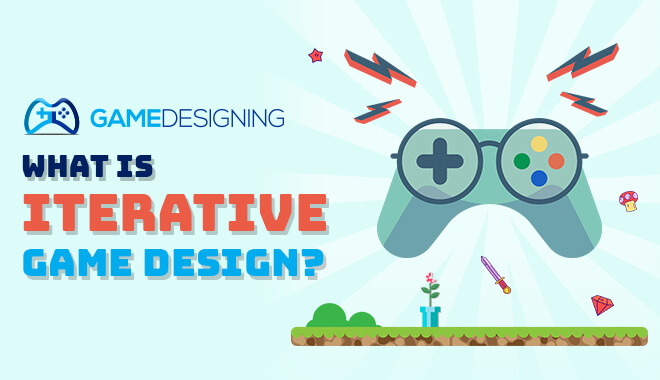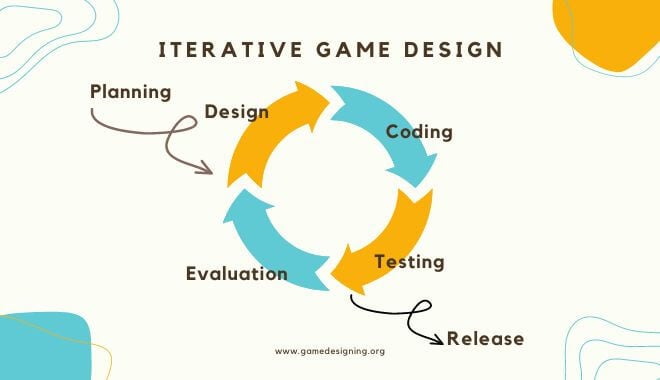
One of the most important steps in game development is iterative game design. It’s built on the idea that games aren’t perfect after one round of development.
It encourages developers to repeatedly perform certain steps in an effort to come up with a final version that is playable, enjoyable, and as technically glitch-free as possible.
Let’s learn more about iterative game design and what it entails.
What Is Iterative Game Design?
An iterative design is a systematic approach to repeating certain steps in game development. It aims to achieve a desirable final product by implementing small changes every time it produces a new software version.
Each iteration is tested until the product is perfect. It entails identifying user needs through research, generating ideas to meet those needs, developing a prototype, and testing it to see if it effectively addresses them.
Just like software, game designs usually undergo multiple iterations or versions until the final product is ready for release.
Chess as an Example of Iterative Game Design
Chess is a common and relatable example of iterative game design. The game includes numerous moves and outcomes. Developing a computerized version requires developers to anticipate all of them.
Since it’s impossible to completely incorporate them in the first version, multiple iterations are necessary.
As a gamer, you might already have noticed game iteration to some extent. Whenever you start a game, modern games usually check for patches and new versions that improve the gaming experience.
Though this example is confined to games that have already been released, it’s still a good example of how developers continue to refine their games according to user needs.
Here’s an interesting fact: the title with the longest development period is Beyond Good & Evil 2. After the idea was pitched in 2008, it remains in development to this day!
6 Stages of Iterative Game Design
When developers want to engage in iterative game design, they have to do the following:
1. Planning
At this stage, developers and game designers decide on the objective of the iteration. Do you want your game to be easier to learn? Are you aiming to give players more freedom? Do you want it to be fun to watch?
These are a few examples of objectives that can be established during the planning stage. During this phase, ideas are pitched and discarded. The best ones are retained for execution.
Planning also becomes more streamlined with each version since each iterative game design process begins with this step.
2. Design
The design stage is when developers analyze how they can meet the objectives established in the planning phase. They have to establish certain parameters like the language they want to use and the number of variations they want to have.
Note that exact metrics will vary from project to project.
With each version, the design terms and conditions become more defined. The designers get a clearer picture of what they have to do and progressively build on that through feedback until the final product is ready.
3. Coding
Coding kickstarts the actual game development process. Coders follow the requirements that were enumerated in the previous steps. They will use a specific computer language and multiple software to write the new code.

4. Testing
This involves testing the code written for bugs, additions, and issues that may have been overlooked in the initial three stages. The people who test the game design could be gamers or in-house game testers who have dabbled in a variety of professional game tests.
Any bugs will be reported and sent back for further coding. The designs will be modified and their codes will be rewritten.
Note that designing, coding, and testing take place in multiple rounds. There is a lot of back and forth that often takes months. This will go on until developers nail the project requirements and the testers are satisfied with the experience.
In rare instances, the three stages take place simultaneously.
5. Evaluation
A team of experts will again evaluate the game and its performance for any bugs. This is the last sweep for quality issues and glitches. At this point, the final results are sent to the manager in charge of the project.
Based on the evaluation, the management team will decide:
- If it’s ready for implementation
- If the execution of the idea needs work
- If it’s flawed and needs to go back to the design stage
6. Release
After all the steps have been successfully completed, the bugs are fixed, and iterations integrated, the final product is ready to be released.
Depending on the project’s requirements, a company may have to actively look out for bugs and fix them even after it’s been released. This is completely contractual and not necessarily part of iterative game design.
Why Engage in Iterative Game Design?
Iterative game designs take time and involve different teams. But when done right, it can make a game smoother, more playable, and a lot better than the first version. Here are some of its benefits:
- It ensures that the vision and design for the game are realized.
- It encourages teams to carefully plan the next iteration before the coding work begins. Meanwhile, coders have the assurance that their work adds value.
- It helps game developers choose and pursue the best ideas.
- It keeps game development teams organized.
- It provides opportunities for testing, allowing coders to remove bugs and glitches.
- It gives stakeholders greater transparency over the game development process.
Continuous testing and coding mean refined results, but they take time. This is why interactive game designs are mostly suitable for big long-term projects. The financial burden and time investment aren’t feasible for small projects.
A Systemic Approach to Game Design
Iterative development is a systemic approach to game design. It works through small variations to achieve high-quality results. This development model is a great choice for large, long-term projects that have the bandwidth for feedback and review stages.
Meanwhile, small short-term projects may not be equipped to handle this approach.
Moreover, its production cycle is flexible, allowing for a quick and reactive approach to design. The coding, design, and testing teams can all work together without having to constantly follow up with each other so game development becomes smoother.
We hope this post has given you a renewed appreciation for the game development process and enabled you to decide if it’s worth adopting.




Leave a Reply